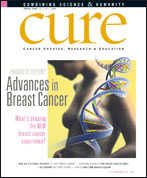Publication
Article
CURE
What Stage Is Your Breast Cancer?
A guide to how breast cancers are staged, from in situ (stage 0) to metastatic (stage IV).
Breast cancer is staged based on the size of the tumor and if and where it has spread, including nearby lymph nodes or distant organs of the body. Staging is defined as TNM: T for tumor size (0 to 4); N for lymph node involvement (0 to 3); M for whether the cancer has spread, or metastasized, to distant organs (0 or 1). Once these attributes have been determined, an overall stage of 0, 1, 2, 3 or 4 (also written as Roman numerals) is assigned.
Stage 0: About 62,000 women will be diagnosed this year with what is called in situ breast cancer—abnormal cells that have not spread from the milk ducts or lobules. Ductal carcinoma in situ is cancerous cells contained within the milk ducts, usually treated with breast-conserving surgery and radiation, or mastectomy. Lobular carcinoma in situ is when precancerous cells are contained in the lobes. Women with LCIS are at high risk for invasive cancer and may be prescribed tamoxifen to prevent further development of the abnormal cells and are advised to increase the frequency of clinical exams.
Stage 1: The tumor measures less than 2 centimeters. Although cancer cells have invaded the fatty or connective tissue, the cancer has not spread outside the breast. Breast-conserving surgery or mastectomy, along with an examination of nearby lymph nodes for errant cancer cells is recommended treatment.
Stage 2A: Tumors can be as large as 5 centimeters without lymph node involvement or less than 2 centimeters but has spread to nearby lymph nodes underneath the arm (called axillary nodes).
Stage 2B: The tumor is between 2 and 5 centimeters and cancer cells have invaded one to three nearby nodes. The tumor can be larger than 5 centimeters as long as it has not invaded axillary nodes.
Stage 3A: The tumor is smaller than 5 centimeters, but has spread to four to nine axillary nodes, which have grown together or into other nearby structures; or the cancer is larger than 5 centimeters and has spread to one to nine axillary nodes.
Stage 3B: The tumor has extended into the chest wall, skin or the ribs and may have spread to no lymph nodes or to as many as nine axillary nodes. It may have spread to internal mammary lymph nodes found on the inside of the chest along the breast bone.
Stage 3C: The cancer has spread to the lymph nodes located above the collarbone and at the base of the neck, or to 10 or more axillary nodes. Inflammatory breast cancer is classified as stage 3 unless it has spread to distant sites, which moves its classification to stage 4.
Stage 4: Cancer cells have traveled to distant nodes and organs of the body, including the brain, lung or liver; considered metastatic breast cancer.




